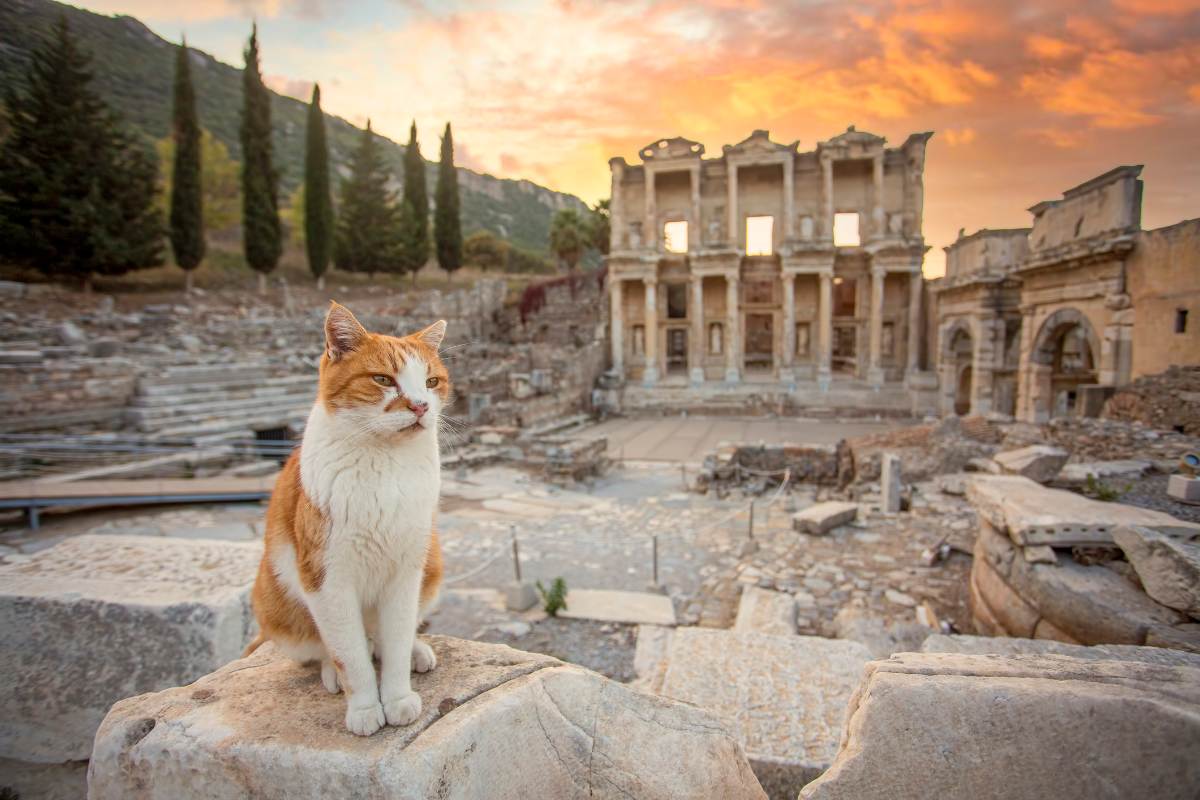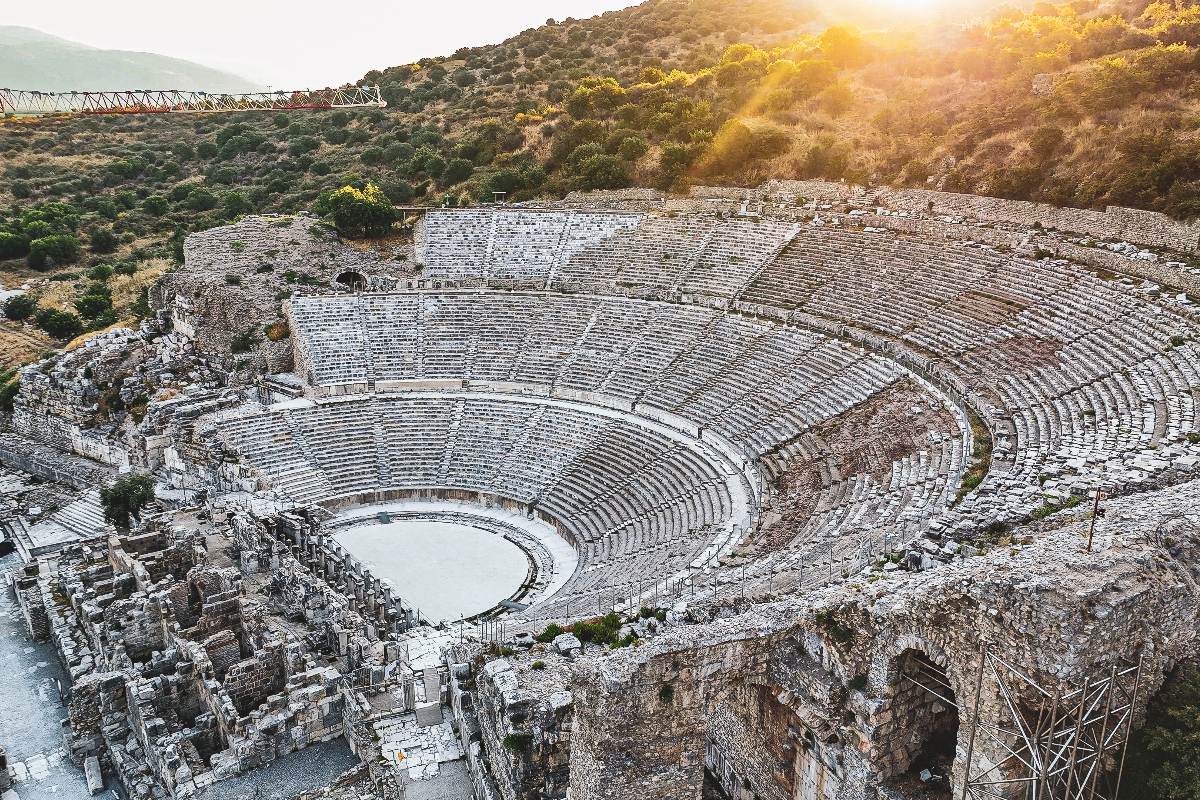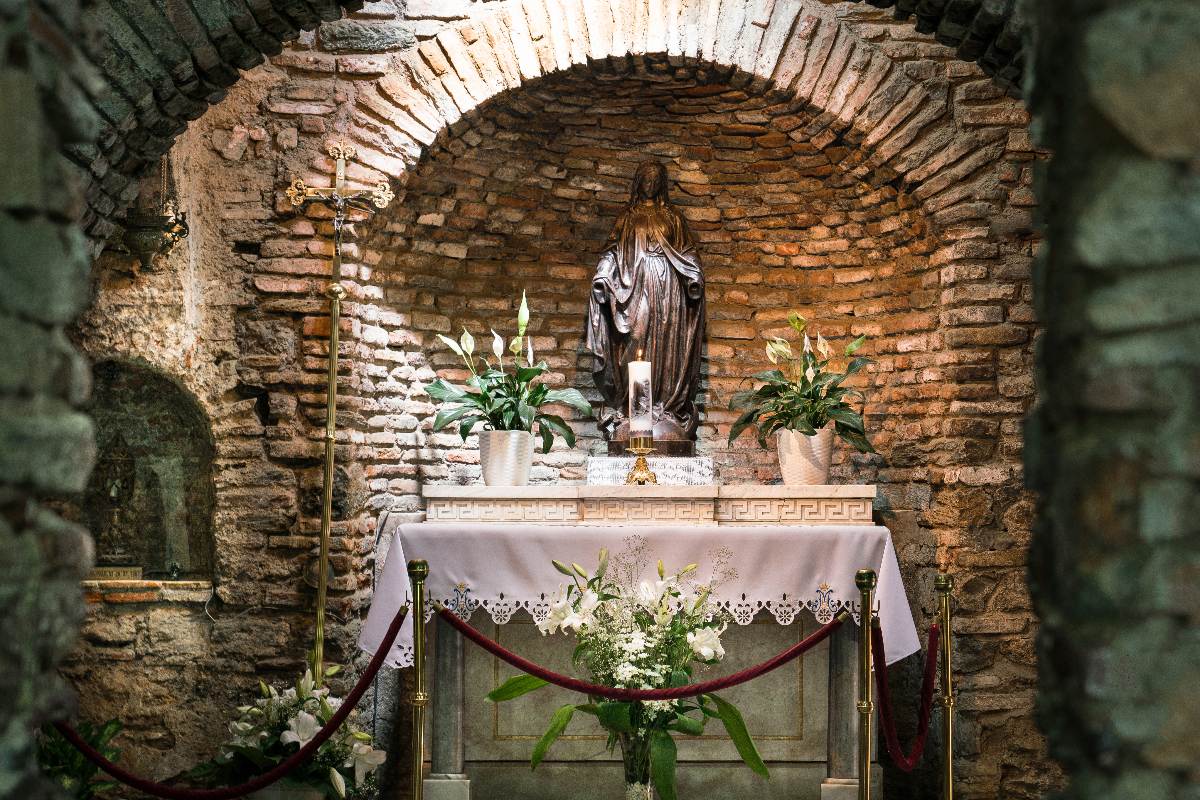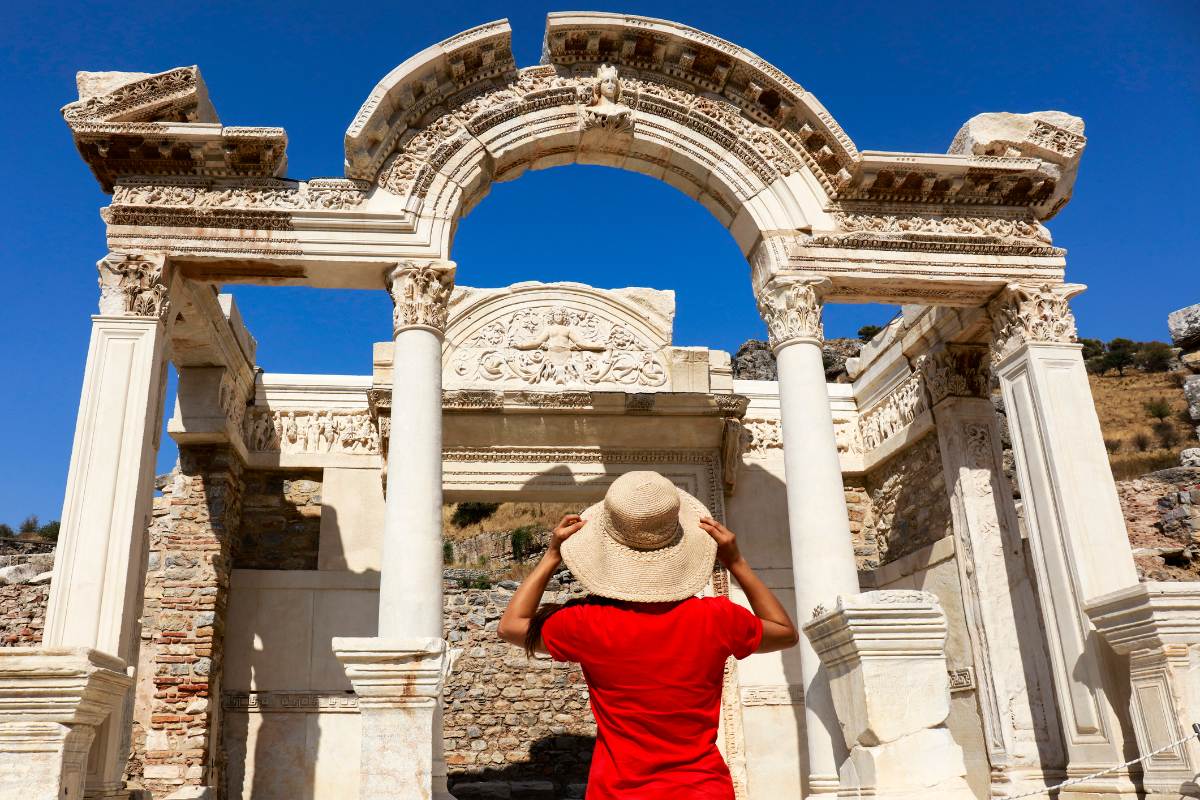Few archaeological sites are as large and well-preserved as Ephesus, one of the largest cities of the ancient world.
Y pocos lugares tienen un poder de evocación cristiana tan potente como la Casa de la Virgen, a unos kilómetros de dicho recinto.
Por ello, visitar Éfeso y la Casa de la Virgen María es una de las etapas fundamentales de todo circuito por Turquía.
Despite being barely 5 km away in a straight line from the Aegean SeaEphesus is not exactly a sun and beach destination, but a cultural one.
Specifically, of history and spirituality.
It is one of the most important archaeological sites of Ancient Greece, when this area of Anatolia was part of what was that civilization, as well as the later Roman and Byzantine civilizations.
But because it is relatively close to sun and beach destinations, such as Kusadasi, Ephesus makes for the perfect day trip as part of a rest and relaxation vacation.
Not for nothing is it recognized as a Unesco World Heritage Sitesince 2015.
Ephesus belongs to the Selçuk districtIt is a city of about 40,000 inhabitants and 3 km from here.
It is also within the province of Izmir, a city located about 80 km north.
Therefore, that city and its airport are the great gateway to Ephesus, although the most common for a traveler visiting this place is to stay in nearby Kusadasi, which has resorts and all the services a tourist needs.
The climate of Ephesus is Mediterranean with a warm summer (Csa)with the addition of a significant relative humidity because it is located very close to the sea.
Therefore, those who come in summer should be well protected from the sun and the high temperatures, which can reach 40º in the central hours of the day.
On the other hand, in winter the temperatures are much more pleasant, which usually do not go below 5º minimum.
In addition, rainfall is quite scarce, so the cold season is also a good option to visit Ephesus, although this will force you to forego swimming in the nearby beaches of the Aegean.
As a world-renowned tourist destination, travel to Ephesus is possible in several ways, from other cities in Turkey as well as from other countries..
A continuación enumeramos todas las posibilidades.
Although only a few hundred meters north of Ephesus there is an airstrip, this infrastructure (Selçuk aerodrome) receives neither domestic nor international commercial flights.
On the other hand, the nearest international airport is Izmir-Adan Menderes airport. (IATA code ADB).
It is located about 65 km north of the archaeological site of Ephesus, which is about 50 minutes by road.
Here is the list of direct domestic and international flights arriving here:
To transfer by public transport from this airport, you can take its shuttle bus or train to Selçuk (and in the case of the bus, also to Kusadasi).
The small town of Selçuk has a train station, which facilitates medium-distance travel to Ephesus.
Specifically, from Izmir and from Denizlitwo other nearby tourist destinations that are very popular due to their proximity to beach resorts in the Aegean (in the case of Izmir) and to Pamukkale-Hierapolis (in the case of Denizli).
This railroad line is not a high-speed line and the approximate times for each route are:
The bus station (otogar) of Selçuk is small and, in fact, it is mainly operated by mainly minibuses connecting this city with other relatively nearby cities.
Some of the direct lines with the greatest offer are:
However, some large companies major bus companies bus companies in the country also offer direct direct routes from other major Turkish cities, such as Istanbul or Ankara.
This is the case of companies such as KamilKoç and Metro.
In some lines, they are night routes (as in the case of the two cities mentioned), while others are day routes (as from Bursa).
Thanks to the large number of holiday resorts on the Aegean coast, Ephesus and its surroundings are well served by highways.
They are as follows, depending on the cardinal point from which you want to access:
To all these transportation options can be added one more: the boat.
Ephesus’ proximity to Kusadasi, a major sun and beach destination with a port, means that many of the tourists ‘disembark’ here for the visit of Ephesus.
But those who do, do not arrive by regular ferries, as the only such operational line connects Kusadasi with the Greek island of Samos, located off its shores.
Therefore, arriving by boat to Kusadasi and, therefore, to Ephesus is only feasible for those who sail on a cruise cruise cruise in Turkey and the Greek Islands.
The origins of Ephesus are lost in the past, mixing the mythical and the real.
Although the The founding of the city is attributed to Androcles, a Greek prince of the 10th century BC.This coastline was already inhabited by various peoples and civilizations, such as the Mycenaeans, Hittites and Léleges.
The latter venerated Cybele, the Phrygian goddess of fertilitythe Phrygian goddess of fertility, who was assimilated with Artemis by their successors, the Ionians.
Therefore, the city and the temple of Artemis existed already in the 7th century B.C., and so did the other pillar of Ephesus’ life: its port. pillar of the life of Ephesus: its portsince the coastline was located at this altitude and not where it is now and not where it is now, about 5 km away due to the progressive accumulation of sediments.
At that time, one of the many invasions many invasions (in this case, by Cimmerians) that damaged the city and the aforementioned temple.
Since then, history repeated itself several times: reconstructions of the temple (one of the largest in antiquity and a very important place of pilgrimage) and of the citywhich slightly changed its location several times.
One of the great devastations of the temple of Artemis (Artemision, as it was also called) occurred in 356 BC, devastated by a fire caused by a certain Erostratus.
But he rose again from the ashes and, soon after, Alexander the Great declared his admiration for the new reconstruction of the temple.
But at his death, Ephesus was again immersed in a period of disputes between Lysimachus (one of his generals) and his rivals, the Seleucids.
The present location of Ephesus dates from this period, moved here to adapt to the changes caused by sediment on the coastline, which obstructed the harbor and caused flooding.
When Ephesus came under Roman dominated by the Romans (133 B.C.), the citythe city experienced an important period of stability and expansionAugustus declared it the capital of Asia Minor (27 B.C.) and it grew rapidly to 250,000 inhabitants. 250,000 inhabitantsaccording to some estimates.
Its rich port commerce and the dynamism generated by the pilgrimage to the temple of Artemis (Diana for the Romans) explain this growth.for the Romans) explain this growth, until it became one of the largest cities in the entire empire.
In this context, Ephesus received the arrival of many important important Christians, such as St. Paul, St. John the Evangelist (who wrote part of his Gospel here, as mentioned in the page of Christianity) and even the Virgin Mary after the death of Jesus Christ, as can be understood in the visit to the famous House of Mary.
But curiously, the progressive decline of paganism and the rise of Christianity caused a crisis in the cult and pilgrimage, thus undermining the local economy.
At the same time, the the port was unstoppable, despite imperial efforts to dredge it.despite imperial efforts to dredge it, causing the collapse and eventual disappearance of this commercial activity. disappearance of this commercial activity. in the following centuries.
By then, in Byzantine timesthe only compelling reason to invest in Ephesus was its religious prestige. religious prestigeThe city was the home of St. John the Evangelist, so that the construction of churches and other structures was promoted in times of different emperors, including Justinian I (6th century) with the basilica of Agios Theologos (John the Theologian, in reference to St. John).
It was also chosen as the site of important councils.
However, the looting continued to be a constant, for example by Goths (3rd century) and Arabs (7th century), until it was finally uninhabited.
By the time the later Turkic rulers (Seljuks and Ottomans) occupied this territory, Ephesus was no longer of any strategic importance.
However, the memory of St. John was also maintained after the Muslim domination, when the current population of Selçuk emerged. the current population of Selçuk aroseThe name derives, by corruption, from Agios Theologos or Ayasoluk.
And its long spiritual and religious tradition could motivate the creation in Selçuk of the Isa Bey Mosque by the Ottomans in the 14th century. 14th centuryvery close to the ancient temple of Artemis.
In any case, between neglect and relative ignorance in the time of the Ottoman Empire, it was reached in the mid-nineteenth century mid-nineteenth centurywhen an expedition of the British Museum began the rediscovery of Ephesus. rediscovery of Ephesus through archaeological work that is still ongoing today and has much to be unearthed.
The Treaty of Lausanne of 1923 caused many Greeks who lived here and were proud of Ephesus’ past to emigrate.
But the Turkish authorities maintain their commitment to promoting Ephesus and the House of the Virgin Mary as an important site for the city. tourist and pilgrimage destinations.
Todo ello en un clima de cierta tensión entre ambos estados, pues esta sigue siendo una hot’ borderThe island of Samos, off the coast of the Bay of Kusadasi, is already Greece, a longed-for destination for many refugees arriving from Middle Eastern countries such as Syria and crossing Turkey to land on European soil, sparking diplomatic rifts.

As is always the case when visiting an archaeological site, a certain amount of imagination is required. imaginationeven in those whose state of preservation is very good.
And so it is in Ephesus: although many of its structures are clearly visible and recognizable, in others you have to imagine in your mind what it must have been like in front of your eyes.
Moreover, here an additional fact is added: Ephesus was a port city.The sea reached the foot of the present archaeological site, so that the 5 km of dry land between the site and the present coastline simply did not exist several millennia ago.
And as if that were not enough, the archaeological work continues and have yet to uncover a large part of what was once that great city.
To organize a day visit to Ephesus, it is convenient to group the points of interest by their proximity: on the one hand, the archaeological site of the ancient city and, on the other hand, the places several kilometers away from the site that, although they are related to it, require the visitor to travel to discover them.
Specifically, the House of the Virgin Mary, the Cave of the Sleepers and the city of Selçuk.

Visiting the archaeological site of Ephesus is like traveling back in time to the ancient world: it is one of the best preserved cities in the world. one of the best-preserved cities of antiquity and also one of the largest, so it will take several hours to discover the most important parts of the site.
The enclosure has two entrances (Upper Gate and Lower Gate).
For the sake of convenience and also because this is how group guided tours usually begin, we list the highlights starting at the upper gate, so that the tour starts slightly downhill:
To exit, you can either use the lower gate or retrace your steps and exit through the upper gate.
It all depends on the means of transportation you used to get to the site.

Very close to the archaeological site of Ephesus but outside of it are two places of enormous interest for Christian pilgrims and for travelers interested in religion and culture in general.
The first and most important is the House of the Virgin Mary, about 8 km from the Upper Gate.
The second, the Cave of the Seven Sleepers, about 2 km from the lower gate.
The House of the Virgin Mary It should not be confused with the church of St. Mary which, as we saw above, is a Byzantine basilica that is part of the archaeological site of ancient Ephesus.
It is known in Turkish as Meryem Ana Evi and, according to tradition, St. John the Evangelist brought the mother of Jesus to this place.The site was discovered and interpreted at the end of the 19th century, when a French priest, following earlier visions of a German nun, Anne Catherine Emmerich, recognized this place.
Its discovery and interpretation took place, instead, at the end of the 19th century, when a French priest, following the previous visions of the German nun Anne Catherine Emmerich, recognized this place.
At that time, the chapel was chapel chapel was built, was built on the basis of the previous structurerecognizable by its orange bricks.
There are doubts about the exact dating of this base, which could be later (Byzantine and not apostolic), although this structure could have been built on top of the aforementioned sacred house.
The place overwhelms by the emotion and spirituality that reigns here thanks to the offerings and wishes deposited by the pilgrims, but also by the beauty of the sculptures and frescoes dedicated to the Virgin Mary, in a green and inspiring environment.
The Cave of the Seven Sleepersis a small temple dedicated to some Christian martyrs of the third Christian martyrs of the third centuryAccording to popular belief, Emperor Decius had this grotto sealed when this group of religious men retired to pray and fell asleep in a deep sleep.
Two centuries later, they opened the grotto and discovered the seven religious, who woke up believing they had slept for a day, and the local bishop decreed the miracle.
Some time later, they were buried in this same place and it became a place of pilgrimage.
As we have commented on several occasions, one of the reasons why Ephesus reached its importance was the Temple of ArtemisIt was one of the largest in the ancient world and a place of pilgrimage that attracted thousands and thousands of worshippers, with a consequent positive effect on the city’s economy.
And it must have been so spectacular that it formed part of what the ancient Greeks considered the Seven Wonders of the Ancient World.
But where is this temple today?
Unfortunately, little remains of that splendorous enclosure, but its ruins are enough to attract those interested in the ancient world.
Its remains can be found on the outskirts of SelçukThe site is located on the western periphery (the part closest to the ancient Ephesus).
Here, in a wide green esplanade, the stones of what was the temple are distributed, remaining standing only a column, as a paradoxical symbolas a paradoxical symbol of what that marvel once was.
The decline of the cult of this pagan goddess, natural disasters, looting by invading peoples and the use of its stone blocks for the construction of other monuments (for example, Hagia Sophia in Istanbul) led to its abandonment and dismantling.
However, walking around here allows evoke its enormous dimensions and the final stage of the pilgrimage made by the faithful coming from other parts of Ancient Greece and the Roman Empire, after disembarking at the port.
There are no sculptures or reliefs of the goddess Artemis, who was worshipped here, but it is known from engravings and inscriptions that her figure was rather syncretic: she was associated with the pre-Hellenistic fertility goddess Cybele, so venerated in this part of Anatolia, as well as with the aforementioned Greek goddess of virginity and hunting (later converted into the Roman Diana).
Finally, also in Selçuk, we can mention the Ephesus Museumwhich is the archaeological museum where the most relevant pieces from the ancient city are exhibited.
Here they are preserved and exhibited for conservation reasons, but also for a better interpretation and contemplation.
Its most outstanding features are its and sculptures, but also exhibitsbut there are also exhibited objects of everyday life (scales, jewelry) and even grave goods.
Among the most iconic pieces are the two marble statues of Artemis, the great deity of thethe great deity of the place, with her numerous breasts numerous breasts, perhaps in reference to her character as protector of fertility, by syncretism with Cybele.

Since there are no tourist information offices in Selçuk there are no tourist information offices to the use and the most common is to come to Ephesus from other surrounding destinations, it is ideal to have already organized and prepared the visit, since at the entrance of the site there are only stores and cafes, as well as the ticket offices where paper guides and simple maps about the site are offered.
Please note that there are two access doors to the archaeological site of Ephesus: the Lower Gate and the Upper Gate.
The most common and used by tour groups in private bus is the Upper Gate, since it allows the tour in slight descent.
On the other hand, the lower gate is quieter and is served by regular public buses leaving from Selçuk.
For those who leave of Selçukthe private cab is a comfortable and affordable option, with a journey time of 7 minutesto both the lower and upper gates.
And in recent years, a new and healthy way of access from Selçuk has become available: a 3.5 km bike path. bike path of about 3.5 km running parallel to the D515 road under the shade of leafy trees to the junction that descends to the left towards the archaeological site.
In addition, you should know that both the House of the Virgin Mary and the Cave of the Seven Sleepers are outside the aforementioned enclosure..
Por tanto, para acceder a ellos tendrás que pensar en cómo realizar esos desplazamiento.
La Cueva está a aproximadamente 2 km de la Puerta inferior, por lo que se recomienda ir en coche, aunque caminar puede ser una opción para quienes estén en mejor forma.
En cambio, la Casa de la Virgen está a 8 km, de modo que el trayecto se hace por carretera en taxi o vehículo privado por una carretera habilitada al efecto.








